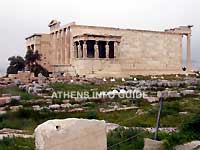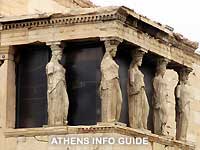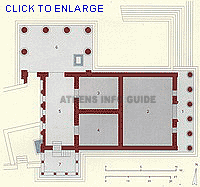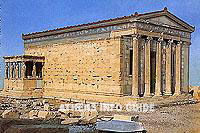
The
Erechteion
The Erechteion is one of the most elegant buildings of the Acropolis
and it dominates the north side of the rock. The temple was built
from 421 till 414 and from 409 till 406 BC on the place where,
according to legend, Athena and Poseidon matched on the name of
the town. On the photo you see the olive tree, Athena's gift to
the town where as Poseidon gave the town a spring.
 The
unknown architect of the Erechteion used the uneven rock to build
an original temple in different parts on different levels. The
temple was dedicated to Athena Polias and to Poseidon but also
to gods of the mythical past of Athens like Erechteus. The monument
was named after him. The
unknown architect of the Erechteion used the uneven rock to build
an original temple in different parts on different levels. The
temple was dedicated to Athena Polias and to Poseidon but also
to gods of the mythical past of Athens like Erechteus. The monument
was named after him.
The
Erechteion has three column galleries, one on the east, one on
the north and another on the south side. The north galleryhas
a monumental door and the famous Caryatids are at thesouth gallery
also know as the Maidens porch. These six women statues are columns
and in spite of their function, they are very elegant. They hold
one leg bent whichbreaks the monotonous vertical axis of the
column. The rich, deep folds of the almost transparent chiton
(robe) give a feeling of diversity and balance. columns
and in spite of their function, they are very elegant. They hold
one leg bent whichbreaks the monotonous vertical axis of the
column. The rich, deep folds of the almost transparent chiton
(robe) give a feeling of diversity and balance.
The
six Caryatids on the monument are copies. Five of the original
are kept in the Acropolis museum. One was taken
along with the Elgin marbles and a lot of other Greek important
historical art, by Lord Elgin and is kept in the British Museum
in London. For many years Greece and its people have urged the
British government to give these artifacts back as they are part
of the rich Greek history and belong to the Greek people. Read
more on the "The
Elgin Marbles" and the "Melina
Mercouri" page. 
 The Erechteion
The Erechteion
as it used
to be
With
its, almost feminine elegance, the Erechteion makes a vivid contrast
to the imposing masculine dignity of the Doric Parthenon.
The
original form of this distinctive rectangular building is unknown
since many parts were destroyed when it was converted to a Christian
church in the 7th century AD. However, it is certain that the
eastern porch of the building, with six slender Ionic pillars,
each 6,8 meters (22,3 ft) tall, gave access to the Temple of Athena
Polia. The last pillar on the right is now in the British Museum.
In
the main hall, the cella, of the temple there was a very ancient
statue, made of olive wood, of the goddess Athena. This was the
statue said not to be of human origin but to have been sent from
heaven to honor the city of Cecrops. This also was the statue
clothed in the Panathenaic celebrations with the peplos garment
embroidered by the Arrhephores virgins. 
|


 The
unknown architect of the Erechteion used the uneven rock to build
an original temple in different parts on different levels. The
temple was dedicated to Athena Polias and to Poseidon but also
to gods of the mythical past of Athens like Erechteus. The monument
was named after him.
The
unknown architect of the Erechteion used the uneven rock to build
an original temple in different parts on different levels. The
temple was dedicated to Athena Polias and to Poseidon but also
to gods of the mythical past of Athens like Erechteus. The monument
was named after him. 
 The Erechteion
The Erechteion










